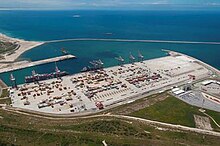Port of Ngqura
| Port of Ngqura | |
|---|---|
 |
|
| Location | |
| Country | South Africa |
| Location | Nelson Mandela Bay Metropolitan Municipality |
| Coordinates | 33°46′00″S 25°40′00″E / 33.76667°S 25.66667°ECoordinates: 33°46′00″S 25°40′00″E / 33.76667°S 25.66667°E |
| Details | |
| Opened |
2009 (commercially) 2012 (officially, by President Jacob Zuma) |
| Operated by | Transnet National Ports Authority |
| Owned by | Transnet National Ports Authority |
| Type of harbor | Artificial |
| Available berths | 4 container berths at -16m Port Chart Datum, 2 general cargo berths at -16m Port Chart Datum and 1 general cargo berth at -18m Port Chart Datum |
| Statistics | |
| Annual container volume | 2.0 million TEU per anum (design capacity) |
| Port Chart Datum | 1.026m below South African Mean Sea Level |
2009 (commercially)
The Port of Ngqura is a deepwater port on the east coast (Indian Ocean) of South Africa, 20 km northeast of Port Elizabeth. It was authorised by an act of parliament in 2002, construction started in September 2002 and the port became operational in October 2009 when the MSC Catania became the first commercial ship to dock at the port.
The Port of Ngqura is South Africa's newest port and the deepest container port in the country. It has an entrance channel -18 m Port Chart Datum in depth, a turning basin of 600 m in diameter and also at -18 m Port Chart Datum, 1 general cargo berth at -18 m Port Chart Datum, and 4 container berth and 2 general cargo berth at -16 m Port Chart Datum.
The Port Chart Datum at the Port of Ngqura is 1.026 m below the South African Mean Sea Level.
The biggest container vessels to have been handled at the port are MCS's 12,500 TEU vessels.
The Port of Ngqura complements the existing ports of South Africa (mainly the twin sister port, Port of Port Elizabeth) and the deepwater ports in Richards Bay and Saldanha.
The first phase construction of the Port of Ngqura Greenfields project commenced in September 2002 and finally came to fruition with the achievement of one of the most important milestones when the first commercial vessel, the MSC Catania, berthed at the Port of Ngqura and off-loaded 275 containers on 4 October 2009.
The Port of Ngqura forms part of the Coega Industrial Development Zone, but falls under the jurisdiction of the Transnet National Ports Authority.
The main intended function of the Port of Ngqura is to service the industrial bulk commodity requirements of the regional and national hinterland. The port was also planned to serve as a container terminal that would relieve congestion in other ports and to serve as a transhipment hub serving primarily the African East and West coast traffic and also inter-line traffic from South America to Asia.
The Port of Ngqura is a deepwater port and the medium to long term expectations are that:
The Port of Ngqura is the only port in South Africa that has an environmental authorization (Record of Decision or RoD) for its construction and operation.
Two of the physical characteristics that had the most significant influence on the lay-out of the port, were the paleo-channel that runs through the site and Jahleel Island that is situated 1 km off-shore. The paleo channel provides the opportunity to provide a deepwater port without the need to dredge large quantities of consolidated material, which results in huge savings in capital dredging. The environmental sensitivity (birdlife / penguin population) of Jahleel Island restricted any development within 500 m of the island. The position of the main breakwater had to be such that the required exclusion zone around Jahleel Island was adhered to.
...
Wikipedia
